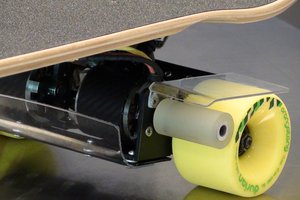Being constructed with a bipedal endoskeleton, actuated by hydraulic artificial muscles, with a deformable surface, the Limboid may physically resemble a human. Its skeletal muscles provide actuation force meeting the demands of many human occupations while internal lithium ion batteries allow it to endure with athletic-level power output for up to one hour. High resolution webcams give the Limboid visual and acoustic sensing capabilities, and pressure pads are positioned at various locations along the robot's environment-oriented surface.
To even try to compete with the high bar set by the human body in ordinary applications at an affordable price, various off-the-shelf components and materials are employed. Articulation does not rely on many custom-machined parts with exotic materials and expensive manufacturing processes, but rather, aluminum extrusions interface using standard joints. As many parts as possible are simplified to reduce complexity and chance of errors and at the same time maximize design for assembly. Actuation does not follow the trend of employing scores of relatively expensive motors with their miles of enameled copper wire, pounds of expensive rare-earth magnets, and dozens of fragile gears. Instead a water-variant of pneumatic artificial muscles allows efficent, high specific power, and responsive control at a very low muscle unit cost. To avert the high costs of valve actuators that directly control the high flow currents for these muscles, staged hydraulic valve actuators direct water flow into or away from a muscle in precise quantities with only a micro-vibration motor interfacing with the very smallest stage of the hydrologic circuit. A beneficial consequence of using these micro-vibration motors is that the control circuitry can be very light with fewer components needed to reduce noise and interface with logic signals. A positive displacement pump drives the entire hydraulic circuit to ensure zero-backfeed in hydraulic current even at stall performance (though we are not operating to that limit). Twin spindle motors turn the pump in a way that dampen each other's acaustic and magnetic environmental impact. Power output traditionally for a multi-motor machine relies on large capacitor banks or even supercapacitors to balance out the load for unexpected spikes in power demand. These systems introduce unnecesary components, complexity, and cost both in the development and operation of the machine. Since the Limboid uses hydraulic power, however, hydraulic energy can be transiently held in a ballast to smooth electrical loads at spikes and cracks in power demand. This extends battery life and motor performance while costing considerably less per unit of energy reserviored than a capacitor bank.
 Jacob Valdez
Jacob Valdez
 Green Harmony Tech
Green Harmony Tech
 Ken Biba
Ken Biba
 Justin Scott
Justin Scott
 Jon Mendenhall
Jon Mendenhall